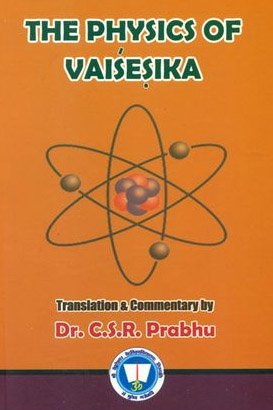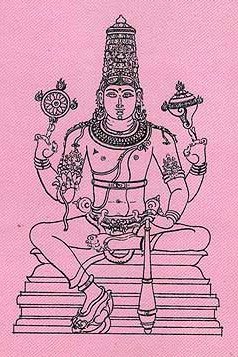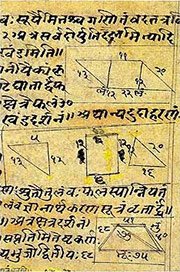Dik: 9 definitions
Introduction:
Dik means something in Hinduism, Sanskrit, Marathi, Hindi. If you want to know the exact meaning, history, etymology or English translation of this term then check out the descriptions on this page. Add your comment or reference to a book if you want to contribute to this summary article.
In Hinduism
Purana and Itihasa (epic history)
Source: archive.org: Puranic EncyclopediaDik (दिक्).—A river. The Mahābhārata, (Bhīṣma Parva, Chapter 9, Verse 18) states that the water of this river was used for drinking by the people in India.
Source: Cologne Digital Sanskrit Dictionaries: The Purana IndexDik (दिक्).—A son of Śatarūpā.*
- * Matsya-purāṇa 4. 25.

The Purana (पुराण, purāṇas) refers to Sanskrit literature preserving ancient India’s vast cultural history, including historical legends, religious ceremonies, various arts and sciences. The eighteen mahapuranas total over 400,000 shlokas (metrical couplets) and date to at least several centuries BCE.
Vaisheshika (school of philosophy)
Source: Wikipedia: VaisheshikaDik (दिक्, “space”) is one of the nine dravyas (‘substances’), according to the Vaiśeṣika-sūtras. These dravyas are considered as a category of padārtha (“metaphysical correlate”). These padārthas represent everything that exists which can be cognized and named. Together with their subdivisions, they attempt to explain the nature of the universe and the existence of living beings.
Source: Shodhganga: A study of Nyāya-vaiśeṣika categories (vaisesika)Dik (दिक्, “space”) refers to one of the nine substances (dravya) according to the Nyāya-Vaiśeṣika school of philosophy (cf. Vaiśeṣikasūtra 1.1.5, Saptapadārthī, Tarkabhāṣā and Bhāṣāpariccheda). Space (dik) is the seventh substance. It is an imperceptible substance which is inferred as the ground of our cognitions of here and there, near and far. According to Nyāya-Vaiśeṣika system, the existence of space is recognized as an external reality and it is perceptible as an objective reality about not a subjective form. Space is one, ubiquitous, eternal, partless and also it is known as the foundation of the world.
Viśvanātha gives the definition of dik (space) as the cause of the notion of distance, nearness etc. This definition is more comprehensive and actual. Radhakrishnan opines that space is the instrumental cause of all effect. Annaṃbhaṭṭa defines dik as the cause of employment of words like east, west, north etc. He also points out in his Dīpikā that space is an instrument cause of all effects.
There is no special quality of space (dik) but it has five general qualities which are number, magnitude, distinctness, conjunction and disjunction. According to Annaṃbhaṭṭa, Viśvanātha etc. dik is one, all pervading and eternal. It has the largest size and it has conjunction with material substances, from which their special positions are recognized. There is also disjunction between dik and material substances. Though space is imperceptible, it can be inferred from the cognitions of different directions.

Vaisheshika (वैशेषिक, vaiśeṣika) refers to a school of orthodox Hindu philosophy (astika), drawing its subject-matter from the Upanishads. Vaisheshika deals with subjects such as logic, epistemology, philosophy and expounds concepts similar to Buddhism in nature
Pancaratra (worship of Nārāyaṇa)
Source: Wisdom Library: PāñcarātraDik (दिक्) refers to an aspect of nṛsiṃha (‘man-lion’), according to the Vihagendra-saṃhitā 4.17, which mentions seventy-four forms (inlcuding twenty forms of vyūha). He is also known as Diṅnṛsiṃha or Diṅnarasiṃha. Nṛsiṃha is a Tantric deity and refers to the furious (ugra) incarnation of Viṣṇu.
The 15th-century Vihagendra-saṃhīta is a canonical text of the Pāñcarātra corpus and, in twenty-four chapters, deals primarely with meditation on mantras and sacrificial oblations.

Pancaratra (पाञ्चरात्र, pāñcarātra) represents a tradition of Hinduism where Narayana is revered and worshipped. Closeley related to Vaishnavism, the Pancaratra literature includes various Agamas and tantras incorporating many Vaishnava philosophies.
Ganitashastra (Mathematics and Algebra)
Source: archive.org: Hindu Mathematics1) Dik (दिक्) (Cf. Diś) represents the number 8 (eight) in the “word-numeral system” (bhūtasaṃkhyā), which was used in Sanskrit texts dealing with astronomy, mathematics, metrics, as well as in the dates of inscriptions and manuscripts in ancient Indian literature.—A system of expressing numbers by means of words arranged as in the place-value notation was developed and perfected in India in the early centuries of the Christian era. In this system the numerals [e.g., 8—dik] are expressed by names of things, beings or concepts, which, naturally or in accordance with the teaching of the Śāstras, connote numbers.
2) Dik (दिक्) (Cf. Diś) also refers to the number 10 (ten) in the “word-numeral system” (bhūtasaṃkhyā).

Ganitashastra (शिल्पशास्त्र, gaṇitaśāstra) refers to the ancient Indian science of mathematics, algebra, number theory, arithmetic, etc. Closely allied with astronomy, both were commonly taught and studied in universities, even since the 1st millennium BCE. Ganita-shastra also includes ritualistic math-books such as the Shulba-sutras.
Languages of India and abroad
Marathi-English dictionary
Source: DDSA: The Molesworth Marathi and English Dictionarydik (दिक्).—(S Inflection of diś Region, quarter, direction. ) In comp. as dikapāla, digbhēda, dikasādhana.
Marathi is an Indo-European language having over 70 million native speakers people in (predominantly) Maharashtra India. Marathi, like many other Indo-Aryan languages, evolved from early forms of Prakrit, which itself is a subset of Sanskrit, one of the most ancient languages of the world.
Sanskrit dictionary
Source: Cologne Digital Sanskrit Dictionaries: Monier-Williams Sanskrit-English DictionaryDik (दिक्):—[from diś] in [compound] for 2. diś, p.480.
Sanskrit, also spelled संस्कृतम् (saṃskṛtam), is an ancient language of India commonly seen as the grandmother of the Indo-European language family (even English!). Closely allied with Prakrit and Pali, Sanskrit is more exhaustive in both grammar and terms and has the most extensive collection of literature in the world, greatly surpassing its sister-languages Greek and Latin.
Hindi dictionary
Source: DDSA: A practical Hindi-English dictionary1) Dik in Hindi refers in English to:—(nm) tuberculosis; (a) vexed, harassed; fed up; —[karana] to harass..—dik (दिक) is alternatively transliterated as Dika.
2) Dik (दिक्):—(nf) direction; quarter; space; ~[kāla] see [dākkāla]; ~[cakra] the aggregate of all directions; ~[pāla] the ten protecting dieties of all the ten directions; ~[śūla] see [diśāśūla; ~sthāpana] orientation; ~[sthiti] bearing.
...
See also (Relevant definitions)
Starts with (+326): Dakkina, Digdarshana, Digvrata, Dika, Dika bread tree, Dika nut, Dika nut tree, Dika-lekhidinu, Dika-malli, Dikaamaali, Dikaamali, Dikadani, Dikadu, Dikahav, Dikahu, Dikaios, Dikala, Dikali, Dikam, Dikamali.
Ends with (+11): Aainu-ddik, Aainuddik, Agnidik, Ain-ed-dik, Apadik, Ashtadik, Audyodik, Ayuvedik, Bhandika, Caturdik, Channadashadish, Daividik, Dandik, Ekadik, Hardik, Ityadik, Karmedik, Khaldik, Mlecchadik, Padik.
Full-text (+154): Dikpala, Ashtadikpala, Dikpati, Grihitadish, Pradarshana, Purvadikpati, Dish, Dravya, Diktulyata, Dikkaravasini, Dikkamini, Diksama, Dikshulalakshana, Ashtadish, Diksundari, Dikcakravala, Diksudrish, Dikkunjara, Dikkari, Dikkanta.
Relevant text
Search found 68 books and stories containing Dik; (plurals include: Diks). You can also click to the full overview containing English textual excerpts. Below are direct links for the most relevant articles:
Vakyapadiya of Bhartrihari (by K. A. Subramania Iyer)
Verse 3.6.20 < [Book 3 - Pada-kāṇḍa (6): Dik-samuddeśa (On Position)]
Verse 3.6.13 < [Book 3 - Pada-kāṇḍa (6): Dik-samuddeśa (On Position)]
Verse 3.6.1 < [Book 3 - Pada-kāṇḍa (6): Dik-samuddeśa (On Position)]
Nyaya-Vaisheshika categories (Study) (by Diptimani Goswami)
Substance (7): Dik (Space) < [Chapter 3 - Dravya (Substance)]
Qualities (7): Pṛthaktva (Distinctness) < [Chapter 4 - Quality and Action]
Divisions of Substance < [Chapter 3 - Dravya (Substance)]
The Agni Purana (by N. Gangadharan)
Chapter 140 - Description of herbs used in charms
Garga Samhita (English) (by Danavir Goswami)
Verse 6.2.9 < [Chapter 2 - Residence in Śrī Dvārakā]
Verse 5.24.97 < [Chapter 24 - The Killing of the Kola Demon]
Verse 1.7.15 < [Chapter 7 - Description of the Conquest of All Directions]
Brihad Bhagavatamrita (commentary) (by Śrī Śrīmad Bhaktivedānta Nārāyana Gosvāmī Mahārāja)
Verse 1.2.93-94 < [Chapter 2 - Divya (the celestial plane)]
Verse 2.1.89 < [Chapter 1 - Vairāgya (renunciation)]
Verse 2.2.67 < [Chapter 2 - Jñāna (knowledge)]
Early Chola Temples (by S. R. Balasubrahmanyam)
Kailasanathar Temple < [Chapter XIV - Conclusion]